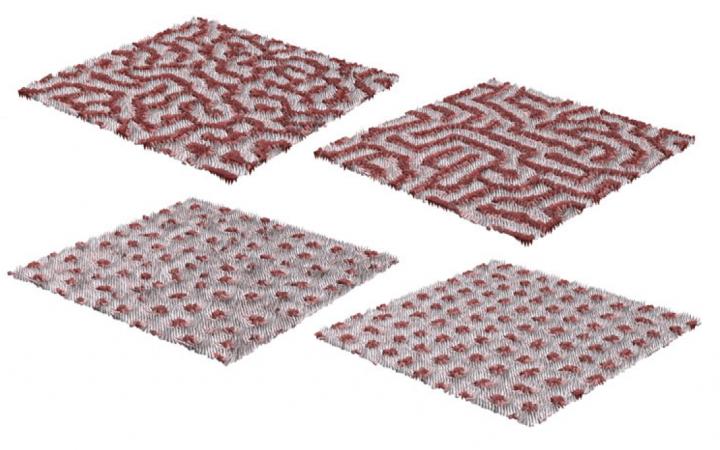Understanding the changing patterns in ferroelectric films

Credit: FLEET
Why do some ferroelectric materials display bubble-shaped patterning, while others display complex, labyrinthine patterns?
A FLEET study finds the answer to the changing patterns in ferroelectric films lies in non-equilibrium dynamics, with topological defects driving subsequent evolution.
Ferroelectric materials can be considered an electrical analogy to ferromagnetic materials, with their permanent electric polarisation resembling the north and south poles of a magnet.
Understanding the physics behind their domain-pattern changes is crucial for designing advanced low-energy ferroelectric electronics, or brain-inspired neuromorphic computing.
Labyrinthine vs bubbles: what patterns reveal
The characteristic domain patterns of thin-film ferroelectric materials are strongly influenced by the type of materials, and by the film configuration (substrate, electrode, thickness, structure, etc).
“We wanted to understand what drives the emergence of one pattern rather than another,” explains Dr Qi (Peggy) Zhang (UNSW), one of the study’s three lead authors.
“For example: what drives formation of mosaic-shaped domain patterning, instead of labyrinth-shaped patterning. And why would drive a subsequent change to bubble-shaped patterning.”
The research team were seeking a common framework or roadmap driving such domain arrangements.
“Is there a topological signature in these states? Is their topology evolutive? And if yes, how so? These are the types of answers we were seeking,” says Dr Yousna Nahas (University of Arkansas).
“We found that self-patterning of ferroelectric polar domains can be understood by examining the non-equilibrium dynamics, and that a common framework is that of phase separation kinetics.
“We also performed topological characterization, and studied pattern evolution under an external, applied electric field, which revealed the crucial role of topological defects in mediating the pattern transformation.”
“The results of this study build a roadmap (a phase diagram of polar domain patterns) for researchers to use when wanting to ‘navigate’ through the plurality of modulated phases in low-dimensional ferroelectrics, says Dr Sergei Prokhorenko (University of Arkansas).
This study is thus interesting in its own field (condensed matter physics, ferroelectrics) but might also be relevant for an interdisciplinary audience in regards to the universality of concepts and results.
The study
Researchers investigated domain features and domain evolutions of thin-film Pb(Zr0.4Ti0.6)O3 (or ‘PZT’) through extensive modelling and experimental study (piezoresponse force microscope).
###
Researchers found that:
- Electric-field control of skyrmion density elicits hysteretic conductance, which could be harnessed for solid-state neuromorphic computing
- Engineering topological order in ferroic systems can enhance functional topological-based properties.
Topology and control of self-assembled domain patterns in low-dimensional ferroelectrics was published in Nature Communications in November 2020. (DOI 10.1038/s41467-020-19519-w)
As well as funding by the Australian Research Council (Discovery and Centres of Excellence programs), support was received from DARPA (TEE and MATRIX programs), and the Vannevar Bush Faculty Fellowship (Department of Defense). Computation was conducted at the Arkansas High Performance Computing Center.
Dr Qi (Peggy) Zhang is a Women in FLEET Fellow.
Media Contact
Errol Hunt
[email protected]
Original Source
http://www.
Related Journal Article
http://dx.





